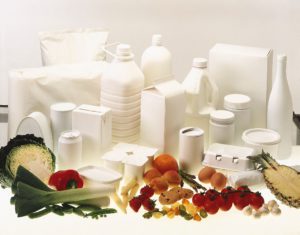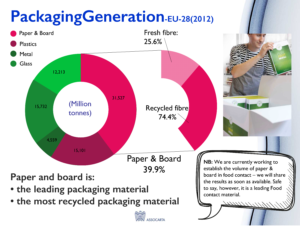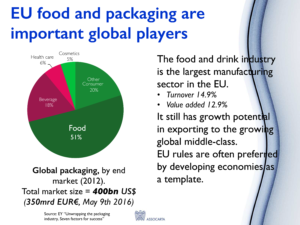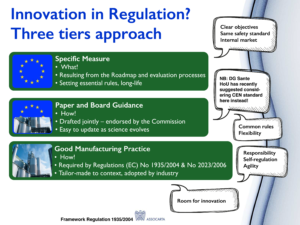Cepi makes the voice of paper heard in Europe. Work has been going on for two years to harmonise legislation on papers and cardboard in contact with food. The objective is to define single clear norms allowing an easier circulation of paper products EU-wide as well as the creation of a strong European single market.
Creating a food contact that is finally able to speak the language of paper. This concept well summarizes the meaning of what the sector is trying to do, and achieve, in Europe in the field of materials in touch with food. The aim is to gradually harmonize the various national norms regulating this area.
This is known to be quite a complex issue. Looking at the European situation on this field, one finds out that that it is also multifaceted, with regulated and unregulated materials and a marked imbalance between materials where the rules have been harmonized and other still waiting for the regulation to take place.
Packaging is the symbol of European commerce, as it is functional to the circulation of goods. And yet, in a Europe that was first and foremost created to establish an internal market, all the aspects applying to packaging and above all to food contact are not harmonized. We are facing extremely diversified situations, also in the field of norms on controls and tests. Mutual recognition in Europe, which was first highlighted as a case law principle and was then stated by a regulation, is a sound and existing principle, yet it is very difficult to apply in practice. The principle of mutual recognition in Europe, which originated as a case law principle and was then enshrined in a regulation, is valid, yet it is difficult to apply. Regulations and good manufacturing practice provide companies with useful indications on how to work, yet univocal reference standards and parameters are lacking.
An advantage for Europe, too
Several Member States have national legislation on food contact and in food import-export activities one inevitably ends up with an overlapping of standards of various countries, thereby making it very difficult to find one’s way through the vast array of norms. This leads to problems in terms of health safety, as well as the possibility of creating the right conditions for a truly internal market and establishing norms that are easy to follow and do not pose additional difficulties. Furthermore, Europe accounts for one quarter of the entire world paper production, but the lack of a harmonized system places it in a situation of competitive disadvantage. The comparison between our system with others, e.g. the US one, clearly highlights that these are larger but more harmonised systems; also China is expected to harmonize its food contact legislation. That is why Europe cannot miss the opportunity to act and communicate at the same level with these realities.
The issue also concerns another topic that is of particular interest to the sector, i.e. circular economy: paper is ideally suited for the concept of circular economy, however clear rules are needed allowing reusing materials both from an industrial and health-related viewpoint, otherwise the risk exists that the system is weak and difficult to implement.
The only solution appears to be that of harmonised norms. In this respect, Cepi has long been working for the drawing up and adoption of a specific single regulation for the paper and cardboard sector. Cepi’s technical manager Eugenio Cavallini tells us about what has been done so far.
The risks we run
«Harmonization is a supply chain operation requiring an open and constructive dialogue between all the parties involved, i.e. authorities, food producers and consumers». Eugenio Cavallini, Cepi’s technical manager.
The paper industry does not want to get bogged down in the sort of comfort zone that many sectors are currently stagnating, as they have preferred to remain in a situation, which, though not ideal, is known to them. This stagnation does not bring any advantages in the long run, that is why the paper industry has decided to take actions, as it is well aware of the fact that without harmonised norms it runs the risk of facing serious problems. As Mr Eugenio Cavallini, Cepi’s technical manager, well explains, «the first risk is legal uncertainty, which poses an obstacle to the rapid response by the sector in case of problems, with the twofold consequence of limiting the guarantee of consumers’ safety and jeopardising the reputation of the paper supply chain». The lack of a single legislation for the sector also generates the risk of reducing its competitiveness. As a matter of fact, «paper-based packaging finds itself in an unbalanced situation compared to other food contact packaging materials, for which legislation exists». Furthermore, the lack of clear norms also «leads to possible negative impacts on recycling activities, which are extremely important for our sector. Similarly, negative effects can be registered in many other sectors, in particular on our customers of the food supply chain». Mr Cavallini finally mentions an aspect that is core to the EU, i.e. the existence and functioning of the European single market. To guarantee the single market, Europe established the principle of mutual recognition, according to which anything produced in compliance with the rules of a Member State should be mutually recognized by all other Member States. Unfortunately, we are all aware of the fact that «said principle is not properly applied».
European inconsistencies
Much has been done to solve this situation, but so far «we have used our resources first and foremost to prove that paper is not plastics, i.e. that the paper industry needs different rules than the ones conceived for the plastic sector», which is often taken as the reference sector when it comes to drawing up the norms to be applied to food contact materials and articles. «This is a massive use of resources, which could be used in different ways».
But the situation is not easy also for other reasons. In Europe, the European Commission is the reference institution for these issues, however «the recent political situation has made the European Commission increasingly cautious when it comes to dealing with new issues and rather more inclined to maintain the status quo». Furthermore, Mr Cavallini explains that in this particular moment all decisions must be authorized at the highest levels. And this does not facilitate new approaches. Difficulties are not limited to presence of excessive red-tape. The paper sector also has to deal with another major problem, i.e. the poor communication of some NGOs often towards consumers, which negatively influences public opinion and consequently exercises strong pressures on European authorities. «This inevitably affects all those who, within the European Commission, have to work towards the development of a new approach». More than that, «the Council of Europe is working on a framework resolution on food contact materials and articles, as well as on guidelines specific for papers and cardboards, however without the involvement of companies and keeping documents classified».
Approach based on three documents
Cepi has had to find its way within this intricate framework pattern and has done so by starting from a clear prerequisite, i.e. the fact that the paper approach used so far is no longer sustainable and cannot be applied to paper and cardboard packaging. «A new point of view and a new strategy are needed. To this end, two groups dealing with the issue of food contact are active within the European association: the Food contact group, dealing with this issue on behalf of Cepi, was sided by the new Fccg, i.e. the Food contact coordination group in 2015, with the latter comprising also other groups of associations active along the supply chain, in particular in the processing sector, and carrying out a coordination activity in the preparation of the proposal on the harmonized measure».
The approach conceived by Cepi, that the association would like to submit to the European authorities, is «based on three documents». The project consists in creating a real regulation taking over the principles of Framework regulation no. 1935/2004, drawing up a guideline specific to the paper and cardboard sector and drafting a guideline on good manufacturing practices.
As Mr Cavallini explains, «the first of the three documents indicates what to do, thereby basically reproducing the contents of regulation no. 1935/04, while the second and third document state how to do it and draw inspiration also from regulation no. 2023/06 on good manufacturing practices. Dialogue with the Directorate-General for Health and Food Safety (DG Santé) has just started, however our intention is to start from the rules already established in the framework regulation and refer to documents 2 and 3». The principles of regulation no. 1935/04 have been basically reproduced, however the intention is to communicate and highlight the actual difference between the process of papermaking and the manufacturing of other products».
This is therefore not a totally new approach, but it rather aims at a more harmonised review of European regulations in a way that takes the paper sector and its specificities more into account.
In this process, the constant relation with companies and consultation between the European Commission and the association are of fundamental importance. «The first document we are proposing is already the subject of consultations. To reach harmonization, however, one needs an open and constructive dialogue between all the parties involved, i.e. authorities, food producers and consumers. This is thus a supply chain operation, whose aim is to improve the functioning of the internal market and minimize costs and burdens for the industry in line with the current trends of management systems».
What still has to be done
Now we just need to carry on with the work started two years ago and continue the dialogue initiated at a European level to finally obtain a harmonised measure. «As urged by DG Santé, a new workshop is currently being organised with the participation of several European authorities active at various levels. The review of the guidelines for paper and cardboard will also continue, this is the second document of the Cepi approach and its draft version has already been prepared. The review of existing good manufacturing practices still has to be done; for this task, the setting up of a task force of representatives of paper and cardboard packaging firms and ink producers was strongly requested». It is difficult to precisely define timing now, however feedback from Brussels experts seems to be positive. Mr Cavallini finally points out that, in any case, whatever the decision of the European Commission after Cepi’s proposal, the latter will be adopted by the paper and cardboard sector for the food contact. «All this work will lead to new documents, what will be adopted by the entire supply chain on a voluntary basis». Harmonizing the norms on food contact materials is a strategic activity for Italy. As Mr Cavallini rightly points out, it is therefore important that these concepts are better communicated and that the way in which the packaging sector works is correctly and properly explained.





